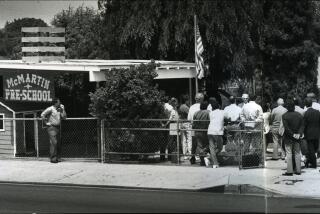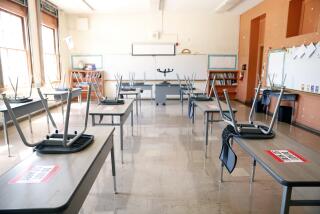Commentary : School Clinic Issue Deserves Rechecking
- Share via
From what I have observed thus far, the Nintendo computer game system comes with a more comprehensive set of instructions and programs than parents and educators acquire with children. In Nintendo, guidelines are tidy and clearly mapped out, and the player needs only to comply with the instructions to perform skillfully.
Oh, were it only so with parenting and education. With innumerable variables such as personality, behavior, intelligent quotient and economic factors, decisions affecting children become so much more onerous. Every decree must be weighed carefully and eventually re-evaluated when the timing is suitable. When the issues immersed in the judgment are emotional and controversial, time bears an important role in determining when best to approach the topic again.
“Time crumbles things; everything grows under the power of time and is forgotten through the lapse of time,” Aristotle wrote.
Almost three years have elapsed since the San Diego Unified School District considered establishing health-care clinics at some high schools. Funded by a private foundation, the centers would have been staffed by professionals who, depending on the program adopted by the district, would provide physical examinations, immunizations, counseling and birth control information.
The district appointed a committee of 30 people from business, educational, health and religious sectors to listen to the public’s opinion, examine the needs of the community, study similar programs in other school districts and make a recommendation to the school board. The committee made a favorable recommendation to the school district.
The board considered the recommendation of the committee, listened to more community debate and assessed that the public was unwilling to accept the role of the school district in this form of health care.
But after three years, and two new board members, it’s time to reconsider issue.
It is fitting to bury the anger and emotional drama that accompanied the idea of school-based health clinics and approach the topic again in a caring milieu. Sufficient time may have passed to allow the various interest groups to approach the issue with facts, and without the distraction of emotion.
The school district will now have more data to present to the community. Educators can interpret the effectiveness of similar programs in parallel communities. Does there still appear to be a need for the clinics in San Diego?
Three years will have allowed religious factions to show how the alternative programs they suggested have been implemented and whether they have met the needs of adolescents.
Three years will have given the medical community and affiliated groups an opportunity to relate how their programs have dealt with the issue of adolescent medicine.
And, in three years, the legions of adolescents and parents will have grown, affording another group an opportunity to study and discuss the issue.
Now is the time for the parents who supported the clinic to determine if their reasoning was accurate. Do they have specific examples where health care on campus might have helped a teen-ager? Moreover, it is an occasion for the parents who opposed the program to render their opinions. May we hear again from the mother of the ninth-grader who saw no need for such support. How have the subsequent years influenced her conviction?
And this mother of four, who now has two high school students? How have the three years affected my views? Bobby McFerrin, the Grammy nominee, sings to me, “Don’t worry, be happy,” my dear friend tells me to pray more, but I am not calmed by what I read, hear or see.
Am I alone in my belief that, although we counsel our children, preach to them, monitor their activities and love them, we still need and benefit from the assistance of other professionals?
Three years later, like other parents, I am chanting “say ‘no’ ” to drugs and alcohol, capitalizing on the merits of abstinence with regard to teen-age sex, stressing good nutrition and asking that wet towels not be left on the bedroom floors. Yet, I am still finding wet towels on the bedroom floors.
I have sat with the anxious friend whose daughter had anorexia nervosa and wondered about other young people. I have heard of the football player who works at gaining weight or the wrestler who attempts to lose weight to wrestle in a different weight class. While discussing vitamins, nutritional supplements and diuretics, I observe adolescents consuming mass quantities of nachos and diet soda.
I have heard the whispered talk of the young girl who needed an abortion and questioned how this might have been prevented.
I have delivered the liturgical reading at the funeral of the friend who died from AIDS and prayed that I would not have to see another mother’s anguish.
I have applauded the PE teacher who introduced the topic of scoliosis and discovered the young girl’s advanced case. I have been told of the curious teen-ager, who, after studying the circulatory system in a science class, had his blood pressure checked at a local shopping center. Three days later, cardiac surgery saved his life. How many others?
And I have winced in the midst of a discussion about the child admitted to a drug and alcohol treatment program as another parent quipped, “Well, I know that none of my teen-agers would ever use drugs or drink alcohol.”
I have seen teen-agers weep over the suicide of a friend and watched parents and teachers question how they might have helped.
The re-evaluation of school-based, health clinics in the San Diego Unified School District. It’s time.
More to Read
Sign up for Essential California
The most important California stories and recommendations in your inbox every morning.
You may occasionally receive promotional content from the Los Angeles Times.













